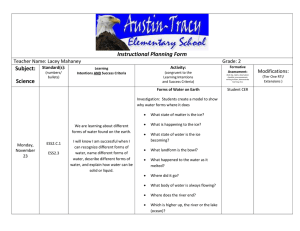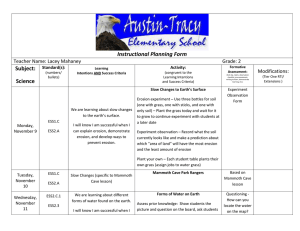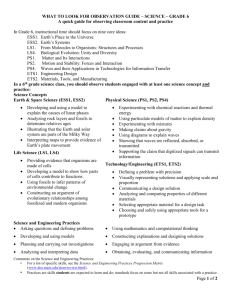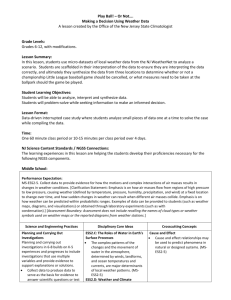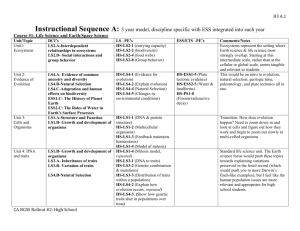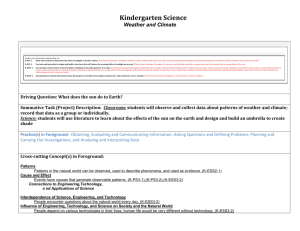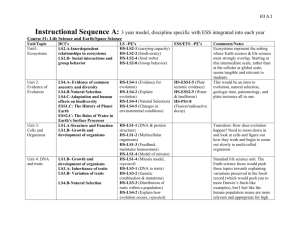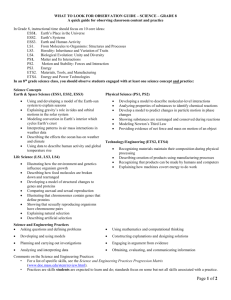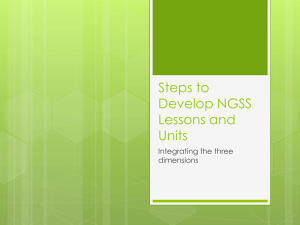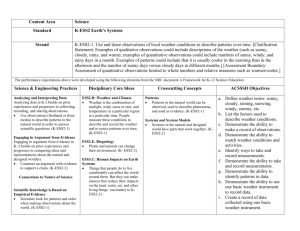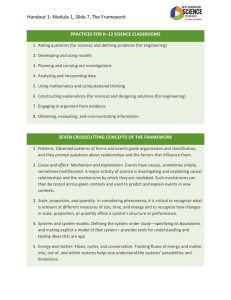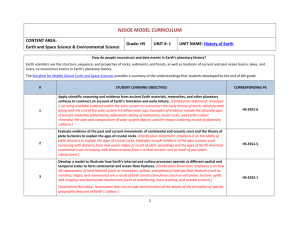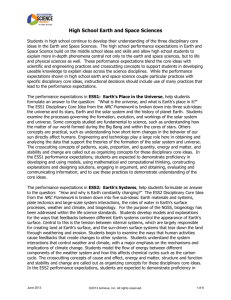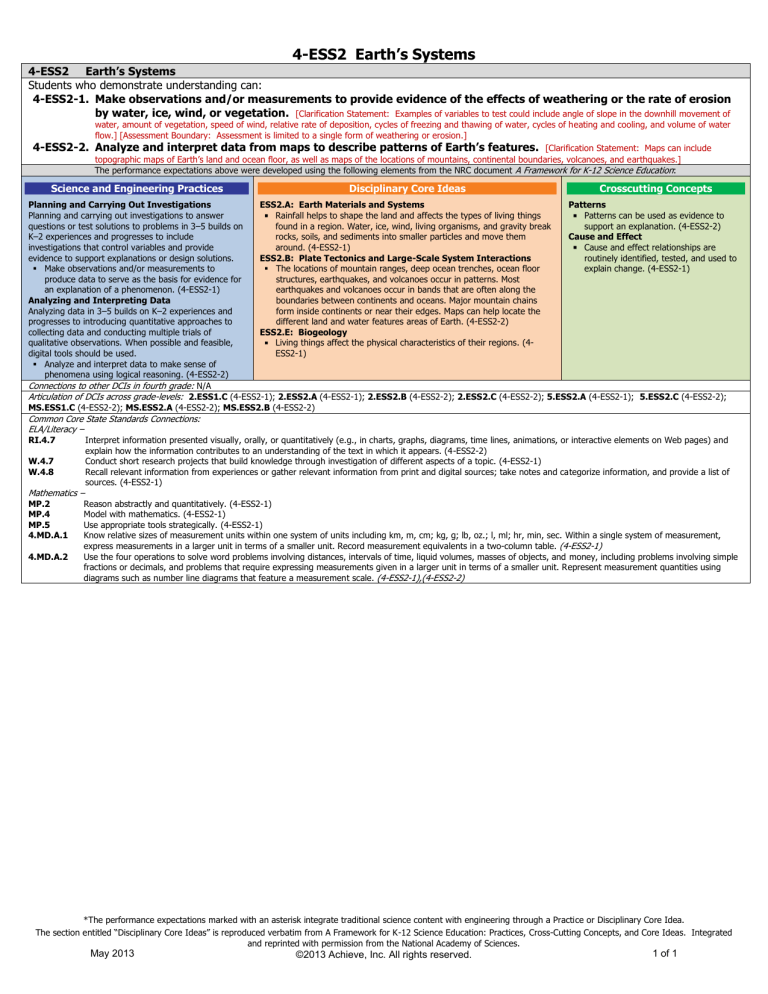
4-ESS2 Earth’s Systems
4-ESS2 Earth’s Systems
Students who demonstrate understanding can:
4-ESS2-1. Make observations and/or measurements to provide evidence of the effects of weathering or the rate of erosion
by water, ice, wind, or vegetation. [Clarification Statement: Examples of variables to test could include angle of slope in the downhill movement of
water, amount of vegetation, speed of wind, relative rate of deposition, cycles of freezing and thawing of water, cycles of heating and cooling, and volume of water
flow.] [Assessment Boundary: Assessment is limited to a single form of weathering or erosion.]
4-ESS2-2. Analyze and interpret data from maps to describe patterns of Earth’s features.
[Clarification Statement: Maps can include
topographic maps of Earth’s land and ocean floor, as well as maps of the locations of mountains, continental boundaries, volcanoes, and earthquakes.]
The performance expectations above were developed using the following elements from the NRC document A Framework for K-12 Science Education:
Science and Engineering Practices
Disciplinary Core Ideas
Crosscutting Concepts
Planning and Carrying Out Investigations
ESS2.A: Earth Materials and Systems
Patterns
Planning and carrying out investigations to answer
Rainfall helps to shape the land and affects the types of living things
Patterns can be used as evidence to
questions or test solutions to problems in 3–5 builds on
found in a region. Water, ice, wind, living organisms, and gravity break
support an explanation. (4-ESS2-2)
K–2 experiences and progresses to include
rocks, soils, and sediments into smaller particles and move them
Cause and Effect
investigations that control variables and provide
around. (4-ESS2-1)
Cause and effect relationships are
evidence to support explanations or design solutions.
ESS2.B: Plate Tectonics and Large-Scale System Interactions
routinely identified, tested, and used to
Make observations and/or measurements to
The locations of mountain ranges, deep ocean trenches, ocean floor
explain change. (4-ESS2-1)
produce data to serve as the basis for evidence for
structures, earthquakes, and volcanoes occur in patterns. Most
an explanation of a phenomenon. (4-ESS2-1)
earthquakes and volcanoes occur in bands that are often along the
Analyzing and Interpreting Data
boundaries between continents and oceans. Major mountain chains
Analyzing data in 3–5 builds on K–2 experiences and
form inside continents or near their edges. Maps can help locate the
progresses to introducing quantitative approaches to
different land and water features areas of Earth. (4-ESS2-2)
collecting data and conducting multiple trials of
ESS2.E: Biogeology
qualitative observations. When possible and feasible,
Living things affect the physical characteristics of their regions. (4digital tools should be used.
ESS2-1)
Analyze and interpret data to make sense of
phenomena using logical reasoning. (4-ESS2-2)
Connections to other DCIs in fourth grade: N/A
Articulation of DCIs across grade-levels: 2.ESS1.C (4-ESS2-1); 2.ESS2.A (4-ESS2-1); 2.ESS2.B (4-ESS2-2); 2.ESS2.C (4-ESS2-2); 5.ESS2.A (4-ESS2-1); 5.ESS2.C (4-ESS2-2);
MS.ESS1.C (4-ESS2-2); MS.ESS2.A (4-ESS2-2); MS.ESS2.B (4-ESS2-2)
Common Core State Standards Connections:
ELA/Literacy –
RI.4.7
W.4.7
W.4.8
Mathematics –
MP.2
MP.4
MP.5
4.MD.A.1
4.MD.A.2
Interpret information presented visually, orally, or quantitatively (e.g., in charts, graphs, diagrams, time lines, animations, or interactive elements on Web pages) and
explain how the information contributes to an understanding of the text in which it appears. (4-ESS2-2)
Conduct short research projects that build knowledge through investigation of different aspects of a topic. (4-ESS2-1)
Recall relevant information from experiences or gather relevant information from print and digital sources; take notes and categorize information, and provide a list of
sources. (4-ESS2-1)
Reason abstractly and quantitatively. (4-ESS2-1)
Model with mathematics. (4-ESS2-1)
Use appropriate tools strategically. (4-ESS2-1)
Know relative sizes of measurement units within one system of units including km, m, cm; kg, g; lb, oz.; l, ml; hr, min, sec. Within a single system of measurement,
express measurements in a larger unit in terms of a smaller unit. Record measurement equivalents in a two-column table. (4-ESS2-1)
Use the four operations to solve word problems involving distances, intervals of time, liquid volumes, masses of objects, and money, including problems involving simple
fractions or decimals, and problems that require expressing measurements given in a larger unit in terms of a smaller unit. Represent measurement quantities using
diagrams such as number line diagrams that feature a measurement scale. (4-ESS2-1),(4-ESS2-2)
*The performance expectations marked with an asterisk integrate traditional science content with engineering through a Practice or Disciplinary Core Idea.
The section entitled “Disciplinary Core Ideas” is reproduced verbatim from A Framework for K-12 Science Education: Practices, Cross-Cutting Concepts, and Core Ideas. Integrated
and reprinted with permission from the National Academy of Sciences.
May 2013
©2013 Achieve, Inc. All rights reserved.
1 of 1

